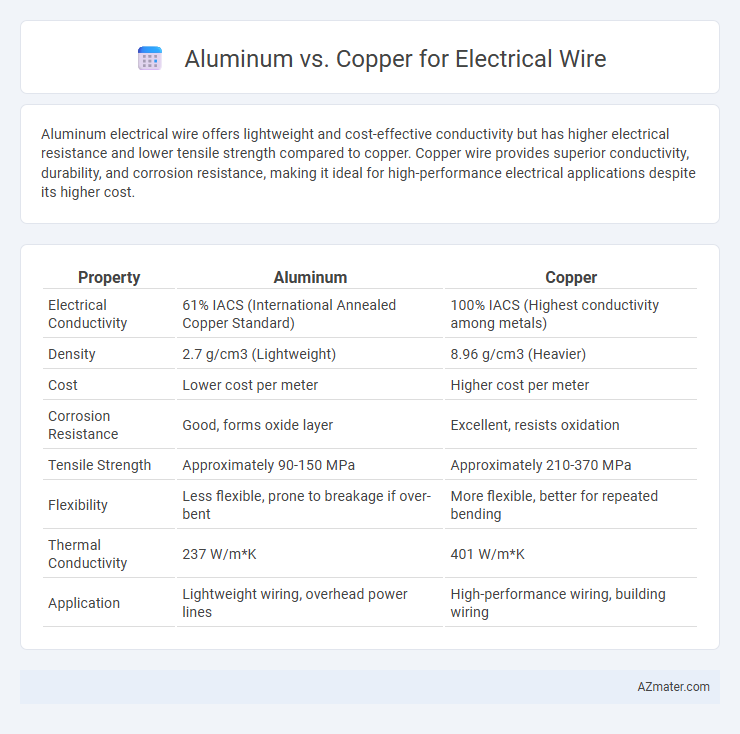Aluminum electrical wire offers lightweight and cost-effective conductivity but has higher electrical resistance and lower tensile strength compared to copper. Copper wire provides superior conductivity, durability, and corrosion resistance, making it ideal for high-performance electrical applications despite its higher cost.
Table of Comparison
| Property | Aluminum | Copper |
|---|---|---|
| Electrical Conductivity | 61% IACS (International Annealed Copper Standard) | 100% IACS (Highest conductivity among metals) |
| Density | 2.7 g/cm3 (Lightweight) | 8.96 g/cm3 (Heavier) |
| Cost | Lower cost per meter | Higher cost per meter |
| Corrosion Resistance | Good, forms oxide layer | Excellent, resists oxidation |
| Tensile Strength | Approximately 90-150 MPa | Approximately 210-370 MPa |
| Flexibility | Less flexible, prone to breakage if over-bent | More flexible, better for repeated bending |
| Thermal Conductivity | 237 W/m*K | 401 W/m*K |
| Application | Lightweight wiring, overhead power lines | High-performance wiring, building wiring |
Introduction to Electrical Wiring Materials
Aluminum and copper are the two primary materials used in electrical wiring, each with distinct electrical conductivity and cost characteristics. Copper offers higher conductivity and durability, making it ideal for residential and commercial wiring where safety and long-term performance are critical. Aluminum provides a lighter, more cost-effective alternative widely used in power distribution and large-scale electrical systems but requires proper connectors to prevent oxidation and ensure safe connections.
Overview of Aluminum and Copper Wires
Aluminum electrical wire offers a lightweight and cost-effective alternative to copper, with good conductivity but higher resistance and a greater tendency to expand and contract with temperature changes. Copper wire provides superior electrical conductivity, durability, and resistance to corrosion, often preferred in residential and commercial wiring for its reliability and longevity. Aluminum requires careful installation and proper connectors to prevent oxidation and ensure safety, while copper's ease of installation and stable performance make it the standard choice in critical applications.
Electrical Conductivity Comparison
Copper exhibits superior electrical conductivity compared to aluminum, with a conductivity of approximately 59.6 x 10^6 S/m versus aluminum's 37.7 x 10^6 S/m. This higher conductivity enables copper wires to carry more current and reduce energy loss in electrical systems. Despite aluminum's lower conductivity, it is favored in applications requiring lighter weight and cost-efficiency, though larger gauge sizes are necessary to match copper's performance.
Cost and Availability Analysis
Aluminum electrical wire offers a cost-effective alternative to copper, with prices typically 30-50% lower per pound, making it a preferred choice for large-scale power distribution. Copper's higher conductivity and durability come at a premium, often influenced by market demand and global supply constraints. Availability of aluminum is generally more stable due to abundant global reserves, while copper's supply can fluctuate, impacting project budgets and timelines.
Weight and Flexibility Considerations
Aluminum electrical wire weighs approximately 55% less than copper, making it a preferred choice for applications requiring reduced overall weight, such as aerial and long-distance power transmission. The lower density of aluminum also contributes to greater flexibility, allowing easier handling and bending during installation compared to copper's stiffer characteristics. Despite aluminum's advantages in weight and flexibility, proper connectors and anti-oxidation measures are critical to ensure reliable electrical performance and prevent issues like thermal expansion and corrosion.
Corrosion Resistance and Longevity
Aluminum electrical wire offers excellent corrosion resistance due to its natural oxide layer, which protects the metal from further oxidation, making it suitable for outdoor and underground applications. Copper wire, while prone to surface oxidation, maintains superior longevity and electrical conductivity, with corrosion typically mitigated through protective coatings or proper insulation. Choosing between aluminum and copper depends on balancing cost efficiency with long-term durability and environmental exposure factors.
Safety and Fire Risk Factors
Copper wires offer superior conductivity and higher melting points compared to aluminum, reducing the risk of overheating and electrical fires. Aluminum wires require careful installation with specialized connectors to prevent oxidation and loose connections, which can lead to arcing and increased fire hazards. Proper maintenance, including regular inspections and tight connections, is essential for aluminum wiring to ensure safety and minimize fire risk.
Installation Practices and Challenges
Aluminum electrical wire requires careful installation practices due to its higher thermal expansion and potential for oxidation, which can lead to loose connections and fire hazards if not properly managed. Specialized connectors with antioxidant compounds and torque specifications are essential to ensure safe, durable connections with aluminum wiring. Copper wire, favored for its superior conductivity and mechanical strength, offers straightforward installation with standard connectors and lower risk of connection failures, making it the preferred choice for most residential and commercial electrical systems.
Industry Standards and Use Cases
Copper remains the preferred conductor in electrical wiring due to its superior conductivity, durability, and resistance to corrosion, aligning with industry standards such as the National Electrical Code (NEC) that prioritize safety and reliability. Aluminum wire, while lighter and more cost-effective, is often used in large-scale applications like power distribution and overhead transmission lines, meeting specific ASTM standards for aluminum alloys and requiring careful installation practices to prevent thermal expansion issues. Both materials serve distinct use cases, with copper dominant in residential and commercial buildings and aluminum favored in utility-scale infrastructure where weight and cost constraints are critical.
Conclusion: Choosing the Right Wire Material
Aluminum wiring offers cost-efficiency, lighter weight, and corrosion resistance, making it suitable for large-scale distribution and overhead power lines. Copper wiring provides superior electrical conductivity, durability, and mechanical strength, ideal for residential and commercial indoor applications where reliability is critical. Selecting the right wire material depends on balancing budget constraints, application requirements, and long-term performance considerations to ensure safety and efficiency.

Infographic: Aluminum vs Copper for Electrical Wire
 azmater.com
azmater.com